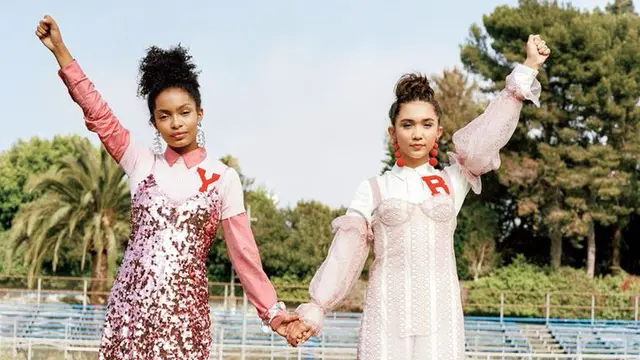In the Trump era,Teen Voguehas become a rallying point of the resistance. But its big sister has ... not.
Vogue's history of tone deafness got worse this week when it released photos from an upcoming fashion editorial featuring supermodel Karlie Klossdressed as a geishacomplete with yellowface.
You'd think most magazineswould know better by now, then again, what is 2017 but a year of regression? If any ofVogue's high-fashion competitors —Harper's Bazaar,W, orTown & Country, for example — had a similar lapse in judgment, the magazine would likely issue a statement and try to move on.
Then there'sTeen Vogue.The teen magazine sharesVogue's legacy name, but has turned itself into a very different publication.Teen Vogue's Trump takedowns and commitment to progressive values havedrawn the attentionof teen and adult readers alike post-election.
It also serves to remind the world just how much betterVoguecould be.
VogueandTeen Vogueshare a publisher: Condé Nast. Beyond that they're two separate publications. But magazine readers aren't always paying attention to who runs what behind the scenes.
When readers seeinterviews with teenage #NoDAPL activistsat Standing Rock in one magazine bearing the"Vogue" name and a glamorization of cultural appropriation the other, it creates a certain cognitive dissonance.
The rise ofTeen Vogue
Launched in 2004,Teen Voguewasn't always political. When I read the magazine as a 15-year-old, it sounded pretty much like its namesake — just with cheaper clothes and younger cover stars.
But in recent years, the magazine has beefed up its coverage of politics and activism. A lot of the credit for that pivot goes to Elaine Welteroth, who in May wasappointed editor — the first black woman to fill that role. Welteroth runs the magazine alongside digital editorial director Phillip Picardi and creative director Marie Suter in a structure that replaces the traditional editor-in-chief.
The teen magazinecovered protests at Standing Rock, went viral with Lauren Duca'sfamed anti-Trump op-ed, and has continued to cover politics since. It takes teenage girls seriously, assuming their interest in both civil rights andAriana Grande.
Teen Voguehas become a point of pride for much of the left —given creditfor reporting what theNew York Timeswon't, even when the magazine's website isaggregatingPolitico.
Putting aside the condescension in much of that praise (do people thinkTeen Vogueis staffed entirely by actual 13-year-olds?),Teen Vogueisfar from the only women's magazinewriting about politics.
Outside of political coverage, the magazine shows a commitment to representation with stories like "7 Girls Show What Beauty Looks Like When It's Not Appropriated."
It feels almost impossible thatTeen Voguewould publish anything close toVogue’s Kloss photo spread today.
Meanwhile, atVogue
Writers forVoguehave covered many of the same stories as theirTeen Voguecounterparts:Standing Rock,gender identity,fashion and activism.
But the magazine's brand and broader editorial ethos hasn't fully caught up to the new realities of the Trump era.Vogue Italiaand FrenchVoguehave had their own problems,as pointed out byThe Cut: Jewelrydescribed as "slave earrings"and a fashion spreadfeaturing blackfacein 2009.
More recently, rumors swirled that First Lady Melania Trump would cover the magazine.
“We have a tradition of always covering whoever is the first lady at Vogue and Ican’t imagine that this time would be any different,” editor-in-chief Anna Wintourtold theWall Street Journalearlier this month.
The cover girls onTeen Vogue, meanwhile, areYara Shahidi and Rowan Blanchard, two actresses and activists. It seems unlikely that Tiffany Trump would follow them.
Voguehas yet to comment on its Karlie Kloss-as-geisha editorial. The spread, to make matters worse, was shot forVogue's "diversity" issue, which featureda group of models on its cover, including Liu Wen, the magazine's first Chinese cover model.
Kloss issued her own apology —similar to the one she gave in 2012after wearing a Native American headdress on the Victoria's Secret runway.
Kloss started out her modeling careerattending casting calls forTeen Vogue.But a lot has changed since then.
Vogueisn't the only magazine to fail at representation, andTeen Vogueisn't the only one to rise to the occasion in Trump's America. (Spokeswomen for both magazines declined to comment for this story.)
As long as the two share a name, it'll be hard to forget the path not taken.
(mashable.com)
 简体中文
简体中文



